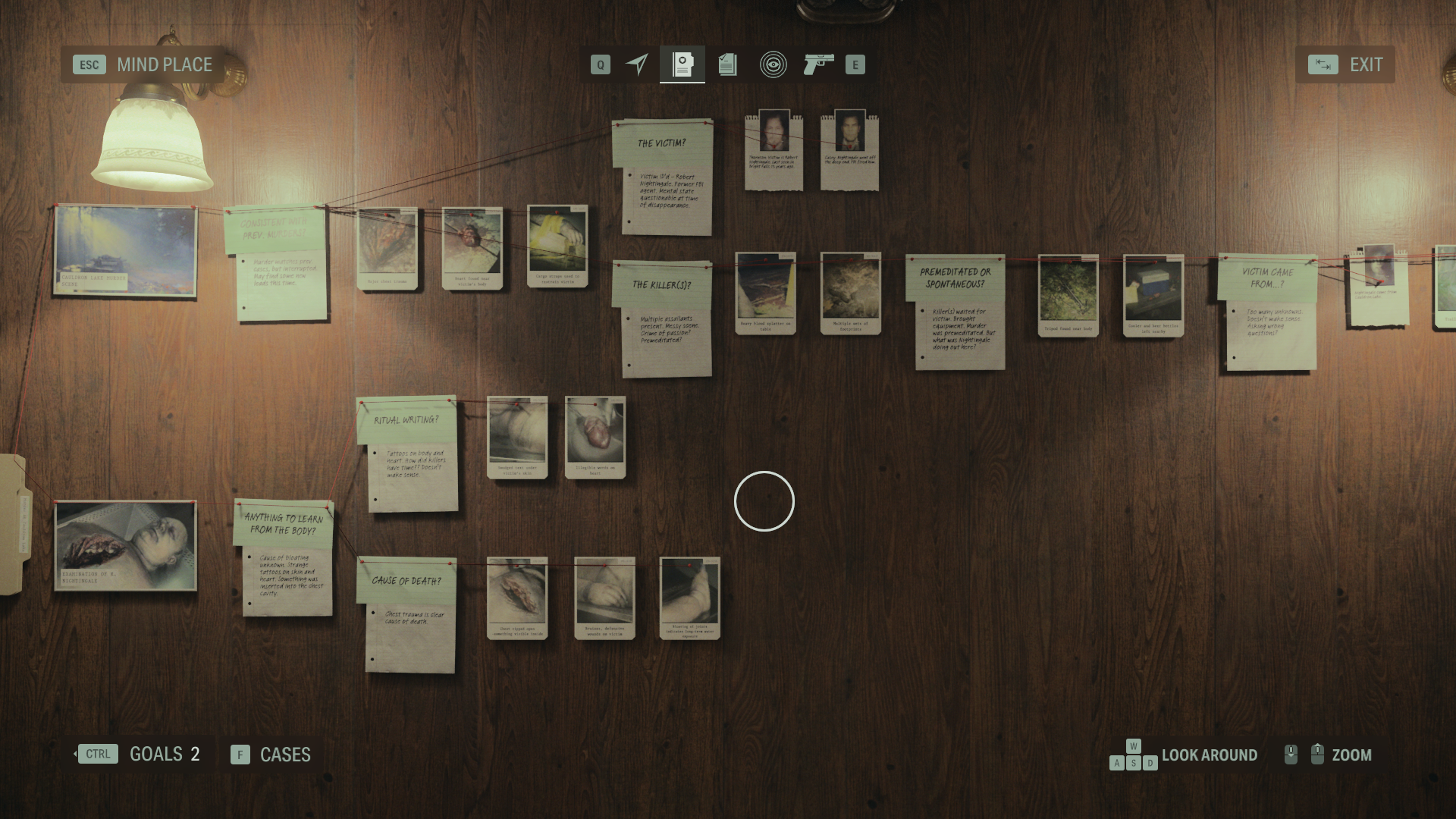Forget the musical numbers and tense battles against evil—the coolest thing in Alan Wake 2 is pinning bits of paper to a wall
Every game from now on should have a big corkboard and a ready supply of thumbtacks.

One of the things that struck me most while I was working on my review of Alan Wake 2 is how many different methods the game has of conveying elements of the story. Beyond the in-engine cutscenes there's also live action sequences, radio shows and television clips, novel pages, photographs, original songs, and more. But my favourite is perhaps the least flashy of all of them: the investigation board.
For this sequel, Alan shares the spotlight with a new protagonist, Saga Anderson. She's an FBI agent on an investigation—to her, all the strange and supernatural events are simply part of a wider case to solve. While playing as her, you can switch at any time between the real world and her 'Mind Place', a sort of imaginary room in her head where she puts together the clues and intuits connections.
In practice, that allows you to conveniently hop between the action at hand and the equivalent of your detective HQ, a cosy, wood-panelled conference room with one entire wall dedicated to the game's mysteries.
Clues you find in the world become little photos, scraps of paper, and flash cards in the Mind Place, ready to be pinned up with bits of string tied between them to indicate possible connections and logical deductions. They might refer to the critical path of the story, reveal some of the motivations of major characters, reveal members of the ever-present Cult of the Tree, or simply point to the location of a useful item. Find all relevant clues for a particular section, and you're rewarded with a little conclusion from Saga, helping wrap things up for anything you've not already pieced together. There's no especially taxing detective work to be done here—you just need to choose the right spot for each clue, and that's never particularly hard. But it's a remarkably satisfying way to pick through Alan Wake 2's story.
In a game where you're usually fearing an ambush around every corner, the Mind Place is safe and calm, giving you the space to digest it all.
With its twisting narrative, frequent trips into a nightmarish otherworld, multi-layered conspiracies, and frequent use of symbolism, it's not always easy to keep a good handle on what's actually going on in Alan Wake 2. Saga's Mind Place gives you a chance to take a breath, look at everything you've seen broken down into individual parts, and quietly arrange it all into the right order. In a game where you're usually fearing an ambush around every corner, the Mind Place is safe and calm, giving you the space to digest it all. It doesn't simply spell things out—Lord knows there are still plenty of baffling things to puzzle over in Alan Wake 2 after the credits have rolled—but it does help you see the bigger picture in an interactive and accessible way.

Every pin is its own cosy little endorphin spike, and I found myself rushing to the Mind Place every time I found a new clue.
It feels like Remedy has looked at all the reddit threads of discussion and story breakdown that follow any game like this and said "Why don't we just make that part of the experience?". Like discussing the plot with others online, your investigation board lets you look at the story from a fresh perspective, noticing connections, references, and parallels that would've otherwise passed you by. It encourages you to dig into the little mysteries in things you might have otherwise overlooked—even the game's collectables get their own sections, where not only can you record everything you've found so far, but also ponder on questions like: Who left these items? Why? And where are they leading me?
Every pin is its own cosy little endorphin spike, and I found myself rushing to the Mind Place every time I found a new clue, eager to expand the web of information. Maybe it says more about me than it does about the game that I get as excited about sticking a bit of paper to a wall as I do fighting the forces of evil, but I do think Remedy's created something really clever here, and I'd love to see other developers take notice. Particularly I think bigger games could benefit from a similar approach—if you've ever tried to remember what's going on in the main story of one of the recent Assassin's Creed games after a 10 hour diversion to hunt treasure chests, you can appreciate how helpful it might be to be able to jump into an interactive web of the characters and events you've seen so far.
Keep up to date with the most important stories and the best deals, as picked by the PC Gamer team.
And come on, let's be honest with ourselves: every time you watch a detective drama or a conspiracy thriller where they break out a corkboard, you secretly dream of making your own. Deep down inside us, there is a primal need to pin bits of paper to walls and tie bits of string between them, too often stifled by society's oppressive norms and a lack of available thumbtacks. Finally, a big budget game is dealing in a power fantasy we can all truly relate to.

Formerly the editor of PC Gamer magazine (and the dearly departed GamesMaster), Robin combines years of experience in games journalism with a lifelong love of PC gaming. First hypnotised by the light of the monitor as he muddled through Simon the Sorcerer on his uncle’s machine, he’s been a devotee ever since, devouring any RPG or strategy game to stumble into his path. Now he's channelling that devotion into filling this lovely website with features, news, reviews, and all of his hottest takes.

